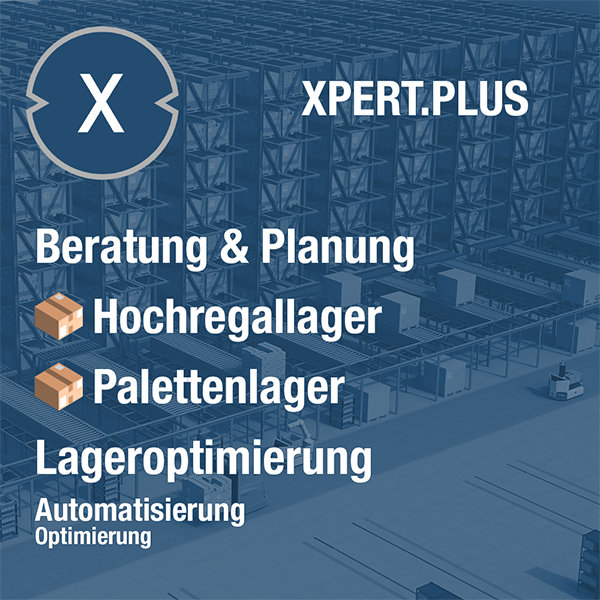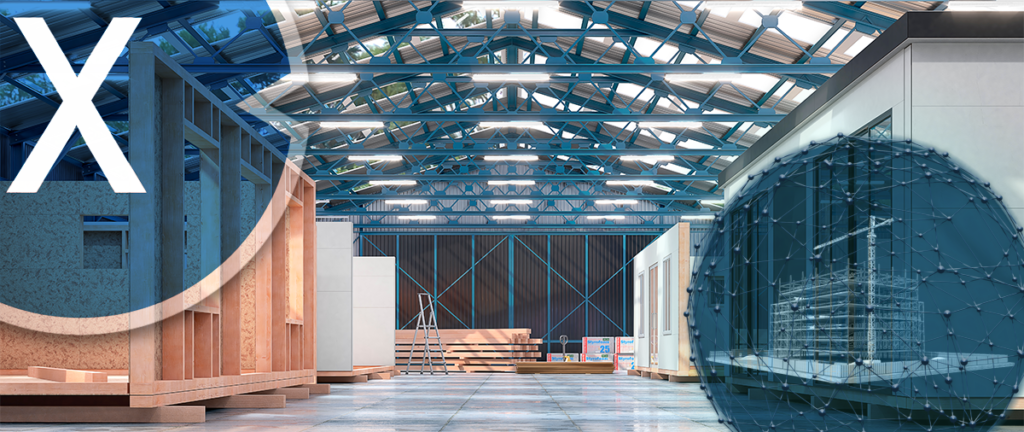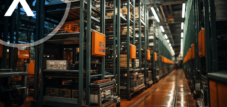Why it's worth continually optimizing warehouse processes - whether in the buffer warehouse, small parts warehouse or high-bay warehouse
Language selection 📢
Published on: August 26, 2023 / update from: August 26, 2023 - Author: Konrad Wolfenstein
🗒️ Why it's worth continually optimizing warehouse processes
Warehouse processes form the backbone of efficient operations. Regular optimization of these processes offers numerous advantages for companies. Here are some reasons why you should continually improve your warehouse processes:
1. Cost savings and increased efficiency
By optimizing warehouse processes, you can reduce inventory levels, make better use of storage space, and increase throughput. This reduces storage costs and increases efficiency.
2. Faster order processing
Well-optimized warehouse processes enable faster picking, packing and shipping of orders. This leads to shorter delivery times and higher customer satisfaction.
3. Minimizing errors
By using modern warehouse management systems and automated processes, human errors can be minimized. This prevents incorrect deliveries and reduces returns.
4. Better inventory control
Regular optimization of warehouse processes enables more precise monitoring of inventory. This prevents overstocks or bottlenecks and optimizes ordering processes.
5. Adaptability to change
Markets, customer requirements and product ranges are constantly changing. Well-optimized warehouse processes are more flexible and can better adapt to changes.
6. Data-driven decisions
Modern warehouse management systems provide extensive data about warehouse performance and activities. This data can be used to make informed decisions and continually improve processes.
7. Competitive advantage
Companies that have efficient warehouse processes can deliver their products faster and provide better service to their customers. This gives them a competitive advantage in the industry.
8. Customer focus
Optimizing warehouse processes makes it possible to react more quickly to customer needs and trends. This leads to better fulfillment of customer expectations.
9. Employee satisfaction
Well-designed warehouse processes can make work easier for warehouse employees by allowing them to spend less time on repetitive tasks. This can increase employee satisfaction.
10. Sustainability
Efficient warehouse processes help reduce waste and environmental impact. This makes both ecological sense and is positive for the company's image.
Continuous optimization of warehouse processes
The continuous optimization of warehouse processes is an indispensable part of a successful company. By investing in modern technologies, making data-driven decisions, and focusing on adaptability, you can realize the above benefits.
📣 Similar topics
- 🚚 Efficient warehouse processes: How cost savings and efficiency go hand in hand
- 📦 Ship faster: warehouse process optimization for shorter delivery times
- 📊 Data-driven inventory management: Use information to make better decisions
- 🌱 Sustainable storage practices: Environmentally friendly approaches to warehouse process optimization
- ⚙️ Automation in the warehouse: How technology reduces human errors
- 💡 Adaptability to change: Optimize warehouse processes for changing markets
- 👥 Increase employee satisfaction: combine ergonomics and efficiency in warehouse processes
- 🏆 Overtaking the competition: warehouse process optimization as a competitive advantage
- 🔒 Master inventory control: avoid bottlenecks, reduce excess inventory
- 🎯 Customer-centric warehouse processes: How warehouse optimization improves customer experience
#️⃣ Hashtag: #Warehouse Process Optimization #EfficientWarehouse #Customer Satisfaction #Sustainability #Competitive Advantage
📣 Energy-related renovation and new construction, consulting, planning and implementation for industry, retail and municipalities
Our experienced team will support you in optimizing your buildings to reduce energy consumption and promote sustainable energy use with photovoltaics. We analyze your individual needs and create tailor-made concepts that make sense both economically and ecologically. Regardless of whether it is about the energy-efficient renovation of existing buildings or the construction of new energy-efficient structures, we are at your side. Industrial facilities, retail buildings and municipal facilities can reduce their energy costs and reduce environmental impact while improving the comfort and efficiency of their buildings through our tailored solutions.
👨🏻 👩🏻 👴🏻 👵🏻 Energy-saving renovation and new construction, advice, planning and implementation for private households
We offer comprehensive support for private households in the energy-efficient renovation and construction of new buildings with photovoltaics. Our experienced team is at your side to help you advise, plan and implement your sustainable energy solutions. We analyze your energy consumption, identify savings potential and develop tailor-made concepts to improve your energy efficiency. From improving building insulation to installing energy-efficient windows and doors to installing photovoltaic and solar systems - we accompany you step by step to make your home more energy efficient and environmentally friendly. Trust in our expertise and benefit from the numerous advantages that energy renovation and the use of renewable energies offer you. Together we will create a sustainable future for your home.

Xpert.Plus warehouse optimization - high-bay warehouses such as pallet warehouses consulting and planning
🗒️ Energetic, energy-efficient and sustainable storage optimization in buffer warehouses, small parts warehouses or high-bay warehouses
In today's economic world, where sustainability and efficiency are becoming increasingly important, warehouse optimization is a crucial factor for the success of a company. The way goods and products are stored can have a significant impact on the energy balance and overall efficiency of a warehouse. In this article we will look in detail at energetic, energy-efficient and sustainable warehouse optimization, especially in the context of buffer warehouses, small parts warehouses and high-bay warehouses for various types of goods, be it small parts or pallet goods.
📦 Energy storage optimization: Efficiency meets sustainability
Warehouse energy optimization refers to the process of designing and operating a warehouse to minimize energy consumption without compromising efficiency. This can be achieved through various measures:
- Lighting optimization: Proper lighting is crucial to saving energy. LED lighting systems are more energy efficient and longer lasting than traditional lighting.
- Temperature and Humidity Control: Precise control of the storage environment contributes to energy efficiency. Modern HVAC systems can reduce energy consumption.
- Automation: Implementing automated systems for moving goods minimizes energy consumption and increases efficiency.
📊 Energy efficiency in buffer warehouses, small parts warehouses and high-bay warehouses
- Buffer warehouse: Intermediate products or goods are stored in buffer warehouses to bridge production bottlenecks. Efficient use of storage space and intelligent arrangement of products contribute to energy efficiency.
- Small parts warehouse: Small parts warehouses accommodate a large number of item variations in a small space. The use of vertical storage systems and optimized shelf arrangements is crucial here.
- High-bay warehouse: Pallets and larger goods are stored in high-bay warehouses. The height of the shelves allows for space-saving storage, but requires efficient lifting and conveying technology.
🌿 Sustainability and environmental awareness in warehouse operations
- Packaging optimization: Sustainability starts with the packaging. Using less material not only saves costs, but also reduces waste.
- Renewable Energy: Integrating solar or wind power to generate energy can reduce dependence on non-renewable energy sources.
- Reuse and recycling: Focusing on reusable packaging materials and implementing an efficient recycling process contributes to sustainability.
🚀 Innovations and trends in warehouse optimization
The constant development of technologies also influences warehouse optimization:
- Artificial intelligence (AI) and machine learning: AI-driven systems can accurately predict inventory levels and determine optimal inventory placement.
- Internet of Things (IoT): By connecting devices and sensors, storage conditions can be monitored and optimized in real time.
- Robotics and drones: Automated robots and drones take on tasks such as picking and inventory, which increases efficiency.
📣 Similar topics
- 🚀 Trends in warehouse optimization: What the future of efficient warehouse operations looks like
- 🌱 Sustainable practices in warehouse management: environmental awareness in focus
- 🔌 Energy saving through smart technologies: IoT and AI in the warehouse
- 📦 Small parts warehouse vs. high-bay warehouse: advantages and disadvantages in comparison
- 💡 Lighting and Energy: Efficient solutions for warehouse environments
#️⃣ Hashtags: #warehouse optimization #energy efficiency #sustainability #innovations #warehouse management
Warehouse optimization is entering an exciting phase where efficiency, sustainability and technology are closely linked. Companies that invest in these areas will not only reduce their operating costs, but also increase their competitiveness and make a positive contribution to the environment.
Trends in warehouse optimization: What the future of efficient warehouse operations looks like
In a world where efficiency and optimization play an increasingly important role, companies are faced with the challenge of optimizing their warehouse operations and adapting them to the changing needs of the market. The future of efficient warehouse operations promises exciting developments that will revolutionize both technology and work processes. Here we take a look at some of the most promising trends that will shape warehouse optimization in the coming years.
🚀 Automation and robotics: increasing efficiency through technology
Advancing automation and robotics play a central role in warehouse optimization. Companies are increasingly relying on automated warehouses in which robots take over the work from picking to packaging. This leads to a drastic reduction in errors and an increase in speed. In addition, intelligent robots enable flexible adaptation to changing requirements.
🌐 IoT and real-time tracking: Transparency along the supply chain
The Internet of Things (IoT) is revolutionizing the way warehouse operations are managed. Integrating sensors into warehouse shelves, forklifts and packaging areas creates a real-time overview of inventory. This enables precise tracking of products along the supply chain and reduces shortages and overstocking.
🛒 E-commerce and omnichannel: adapting to changing consumer habits
The growing e-commerce market requires more flexible warehousing. Warehouses must not only meet the high demands of online order processing, but also be seamlessly integrated into physical stores. This leads to the need for an omnichannel approach where inventory is synchronized across different sales channels to ensure a seamless experience for the customer.
📊 Data Analytics and AI: Informed Decision Making
The increasing amount of data generated in a warehouse operation opens up the opportunity to gain valuable insights. By using data analytics and artificial intelligence (AI), inventory levels can be accurately predicted, delivery times optimized and even maintenance needs predicted. This enables proactive decision-making and helps minimize operational disruptions.
🌱 Sustainability and green warehouse operations: acting responsibly
Warehouse optimization of the future takes into account not only efficiency, but also environmental impact. Sustainability is becoming an important factor as companies strive to reduce their environmental footprint. This can be achieved through the use of renewable energy, the use of reusable packaging materials and the optimization of transport routes.
📦 Space optimization and warehouse layout: Maximum utilization of space
Efficient warehouse operations require intelligent use of space. Companies will work harder to optimally design their storage areas in order to make the best possible use of the space. This can be achieved through the use of high bay warehouses, intelligent shelving systems and automated shelf placement.
🔒 Security and privacy: Protect sensitive information
With increasing connectivity and data collection, security and privacy is critical. Warehouse operations must ensure that their IT infrastructure is protected from cyberattacks and that the data collected is kept confidential.
👥 Training and employee development: Qualified workforce
The introduction of new technologies requires well-trained employees. Warehouse operations will increasingly invest in training programs to prepare their employees to operate automated systems and use new technology.
🚛 Supply chain resilience: Flexibility in turbulent times
Recent global events have highlighted the importance of supply chain resilience. Warehouse operations will develop strategies to respond to unforeseen disruptions such as supply shortages or natural disasters. This may include building emergency buffers, diversifying suppliers and using alternative transport routes.
📣 Similar topics
- Automation and Robotics: The Future of Warehouse Operations 🤖
- Real-time tracking and IoT: Transparency along the supply chain 🌐
- Omnichannel Strategies: Warehousing for the Modern E-Commerce Age 🛒
- Data analysis and AI in the warehouse: intelligent decision making 📊
- Sustainable warehouse operations: Green ways to efficiency 🌱
- Space optimization in the warehouse: use it cleverly, design it optimally 📦
- Security and data protection in warehouse 4.0 🔒
- Qualified teams for modern warehouses: training and development 👥
- Supply chain resilience: Staying flexible in an uncertain world 🚛
- Warehouses of the future: innovations that are revolutionizing the industry 🚀
#️⃣ Hashtags: #warehouse optimization #automation #real-time tracking #ecommerce #sustainability
Sustainable practices in warehouse management: environmental awareness in focus
At a time when environmental protection and sustainability are becoming increasingly important, it is essential that companies also apply sustainable practices in warehouse management. A conscious use of resources and environmental sustainability are at the center of these efforts. In this post, we will explore some important aspects of sustainable warehouse management practices and how they can help reduce environmental impact.
🗒️ Sustainable warehouse design and layout
An important first step towards sustainable warehouse management is the design and layout of the warehouse. Efficient use of space, optimized storage spaces and clever arrangement of shelves can not only maximize storage capacity but also minimize energy consumption. This enables short distances and lower transport costs.
🗒️ Use renewable energy sources
Integrating renewable energy sources such as solar or wind energy can make the warehouse more sustainable. Such sources can be used to power lighting systems, heating and cooling, and electronic devices. This not only helps reduce emissions, but also reduces energy costs in the long term.
🗒️ Efficient warehousing and inventory management
An efficient warehousing and inventory management system can help avoid overstocking and reduce waste. By using technologies such as RFID (Radio-Frequency Identification) and automated warehouse management systems, inventory levels can be closely monitored. This minimizes losses and promotes better planning.
🗒️ Sustainable packaging materials
Using environmentally friendly packaging materials, such as recyclable cardboard boxes and biodegradable cushioning materials, helps reduce waste and protect the environment. Less packaging material also means lower costs and less resource consumption.
🗒️ Optimization of supply chains
Optimizing supply chains can reduce the need for transportation and the associated emissions. This can be achieved through better coordination, route planning and the use of environmentally friendly means of transport.
🗒️ Waste management and recycling
Thoughtful waste management that promotes recycling and reuse is of great importance. Warehouses can serve as collection points for recyclable materials, helping to reduce overall waste.
🗒️ Employee training
Employee awareness of sustainable warehouse management practices is essential. Training and awareness activities can help ensure that all employees implement environmentally friendly behavior in the warehouse.
🗒️ Monitoring and reporting
Regularly monitoring environmental impacts and producing sustainability reports can help companies track their progress and identify areas for improvement.
🗒️ Use technological innovations
The use of advanced technologies such as IoT (Internet of Things) and artificial intelligence can lead to better control of warehouse processes. Real-time data can be used to optimize energy consumption and identify bottlenecks early.
🗒️ Partnerships with sustainable suppliers
Choosing suppliers that also follow sustainable practices can increase the impact across the entire supply chain. Together, companies can help promote environmentally friendly standards.
🗒️ Sustainability in warehouse management
These measures illustrate how sustainability can be achieved in warehouse management. Companies that rely on these principles not only contribute to environmental protection, but can also reduce costs and strengthen their market position in the long term.
📣 Similar topics
- 🌱 Sustainable warehouse design: efficiency meets environmental protection
- 🔄 Reducing waste: Sustainable inventory management in focus
- ☀️ Green energy in the warehouse: use of renewable sources
- 📦 Environmentally friendly packaging: step by step towards sustainability
- 🚚 Efficient supply chains: Less emissions, more sustainability
- ♻️ Waste management 2.0: Recycling strategies in the warehouse
- 👥 Training for sustainability: employees as environmental ambassadors
- 📊 Monitoring for environmental protection: Transparency in warehouse management
- 🤖 Technology for Green: IoT and AI in the sustainable warehouse
- 🤝 Partnerships for sustainability: Suppliers as key partners
#️⃣ Hashtags: #SustainableWarehouseManagement #EnvironmentalProtectioninLager #GreenLager #SustainableSupplyChains #EfficientWarehouse
Xpert.plus-logistics advice and logistics optimization-industry expert, here with its own 'Xpert.digital Industrie-Hub' of over 1,500 specialist contributions
Xpert.Plus is a project from Xpert.Digital. We have many years of experience in supporting and advising on storage solutions and in warehouse optimization, which we bundle in a large network under Xpert.Plus.
I would be happy to serve as your personal advisor.
You can contact me by filling out the contact form below or simply call me on +49 89 89 674 804 (Munich) .
I'm looking forward to our joint project.
Xpert.Digital – Konrad Wolfenstein
Xpert.Digital is a hub for industry with a focus on digitalization, mechanical engineering, logistics/intralogistics and photovoltaics.
With our 360° business development solution, we support well-known companies from new business to after sales.
Market intelligence, smarketing, marketing automation, content development, PR, mail campaigns, personalized social media and lead nurturing are part of our digital tools.
You can find out more at: www.xpert.digital – www.xpert.solar – www.Xpert.Plus



























